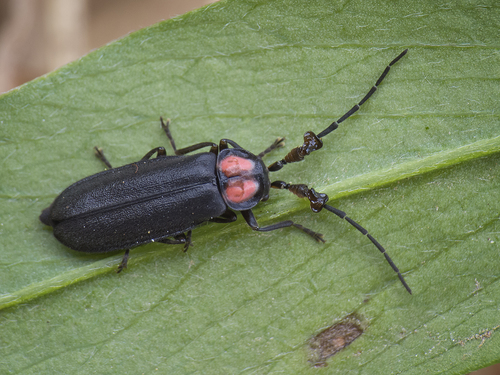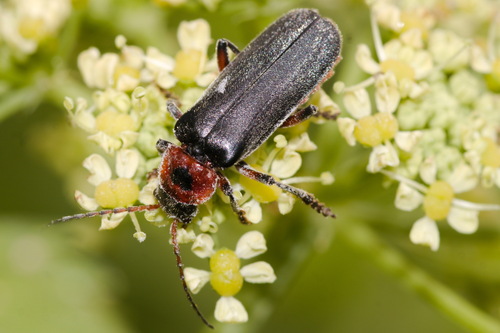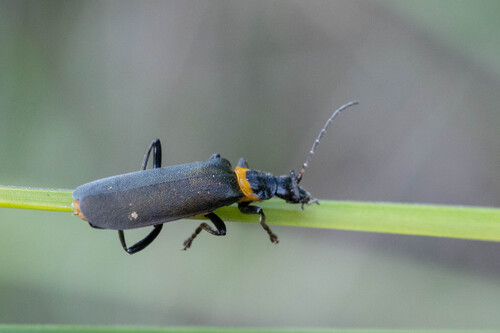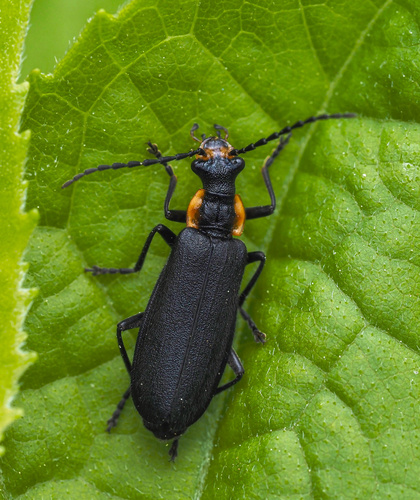Soldier Beetles: Difference between revisions
No edit summary |
|||
| Line 32: | Line 32: | ||
[[File:beetle3.jpg|501px|thumb|center|Rustic Soldier Beetle (''Cantharis rustica'') On a Plant in France (Photographed by dromensis, 2025)]] | [[File:beetle3.jpg|501px|thumb|center|Rustic Soldier Beetle (''Cantharis rustica'') On a Plant in France (Photographed by dromensis, 2025)]] | ||
''Cantharis'' species are usually gray-brown with a red or orange head and prothorax <ref name= "colorado">Colorado State University. (2017). Soldier Beetle. Western Colorado Insects. https://wci.extension.colostate.edu/wp-content/uploads/sites/14/2017/03/SoldierBeetles.pdf.</ref>. | ''Cantharis'' species are usually gray-brown with a red or orange head and prothorax. <ref name= "colorado">Colorado State University. (2017). Soldier Beetle. Western Colorado Insects. https://wci.extension.colostate.edu/wp-content/uploads/sites/14/2017/03/SoldierBeetles.pdf.</ref>. Beetles in this genus are common in grasslands and forb fields. | ||
===Chauliognathus=== | ===Chauliognathus=== | ||
Revision as of 19:25, 14 April 2025
Description & Overview
Soldier beetles (Cantharidae) are the second largest group in the beetle (Coleoptera) superfamily Elateroidea, containing approximatley 5,500 species. These beetles are common throughout the temperate region of the northern hemisphere [1]. Soldier beetle larvae tend to be darkly colored and look almost reptilian. Adult soldier beetles grow to about half of an inch long and vary from yellow, to orange, to brown, or to black in color. Some abdominal segments are exposed, as their wings do not entirely cover their body. These insects are beneficial, as they act as a pollinator species [2].
Currently, 25 species in 16 genera of soldier beetles have been discovered in the fossiliferous resin Burmese amber. The oldest soldier beetle fossil discovered comes from Early Cretaceous Lebanese amber [3].
Soldier beetles may be confused with certain species of blister beetles, fireflies, or glowworm beetles [4].
 | ||||||
|---|---|---|---|---|---|---|
| Kingdom | Phylum | Subphylum | Class | Order | Suborder | Family |
| Animalia | Arthropoda | Hexapoda | Insecta | Coleoptera | Polyphaga | Cantharidae |
Ecology & Evolution
From midsummer to early fall, soldier beetles tend to pollinate yellow flowers of the family Asteraceae. Some adult soldier beetles feed on nectar, pollen, and small arthropods [7]. Other adults may prey on aphids and other soft-bodied insects [4].
Soldier beetle eggs are laid from late August to early September. After winter, beetles emerge and are found moving through leaf litter, plant debris, and other areas of high humidity [2]. Though soldier beetle life history is not well known, larvae are assumed to predate on small invertebrates within the soil. Some soldier beetles are able to produce compounds that help stave off predators, like spiders [7].
Based on molecular dating, the Cantharidae family is thought to have originated 156.3 million years ago [1].
Common Soldier Beetle Genera
Cantharis

Cantharis species are usually gray-brown with a red or orange head and prothorax. [7]. Beetles in this genus are common in grasslands and forb fields.
Chauliognathus

Most Chauliognathus species are found in the western United States, Australia, and South America, excepting two species in the state of Virginia. Adults in this genus are medium in size (8 to 15 millimeters long), and they are yellow to orange with black coloration on their forewings and prothorax [8].
Podabrus

Species in the Podabrus genus tend to feed on aphids and soft-bodied insects [9].
References
[1] [2] [7] [5] [4] [3] [8] [9] [6]
- ↑ 1.0 1.1 1.2 Motyka, M., Kusy, D., Biffi, G., Geiser, M., Kazantsev, S.V., Bilkova, R., Jahodarova, E., Vogler, A.P., Bocak, L.. (2023). Untangling the evolution of soldier beetles (Coleoptera: Cantharidae) and the evaluation of the morphological phylogenetic signal in a soft-bodied elateroid lineage. Cladistics. 39: 548-570. https://doi.org/10.1111/cla.12555.
- ↑ 2.0 2.1 2.2 Hahn, Jeffrey. (2023). Soldier beetles. University of Minnesota Extension. https://extension.umn.edu/yard-and-garden-insects/soldier-beetles#:~:text=Soldier%20beetles%20are%20beneficial%20insects&text=Because%20of%20their%20frequent%20contact,go%20away%20on%20their%20own.
- ↑ 3.0 3.1 Entomology Today. New Soldier Beetle Species Found in 99-million-year-old Amber. Entomological Society of America. https://entomologytoday.org/2016/10/14/new-soldier-beetle-species-found-in-99-million-year-old-amber/.
- ↑ 4.0 4.1 4.2 UCIPM. (2025). Soldier Beetles. UCIPM. https://ipm.ucanr.edu/natural-enemies/soldier-beetles/#gsc.tab=0.
- ↑ 5.0 5.1 BugGuide. (2025). Family Cantharidae - Soldier Beetles. BugGuide. https://bugguide.net/node/view/118/tree.
- ↑ 6.0 6.1 iNaturalist. https://www.inaturalist.org/.
- ↑ 7.0 7.1 7.2 7.3 Colorado State University. (2017). Soldier Beetle. Western Colorado Insects. https://wci.extension.colostate.edu/wp-content/uploads/sites/14/2017/03/SoldierBeetles.pdf.
- ↑ 8.0 8.1 Catron, K.A.. (2021). Biology of Chauliognathus spp. (Hentz) (Coleoptera: Cantharidae) in Virginia agroecosystems. Virginia Polytechnic Institute and State University. https://vtechworks.lib.vt.edu/server/api/core/bitstreams/f6f5fd1b-f813-4947-a14a-1b06d989fc18/content.
- ↑ 9.0 9.1 Montana State University. (2022). Podabrus sp. Montana State University. https://www.montana.edu/yellowstoneinsects/coleoptera/cantharidae/podabrus_sp.html#:~:text=Podabrus%20is%20a%20genus%20in,exclusively%20near%20bodies%20of%20water.